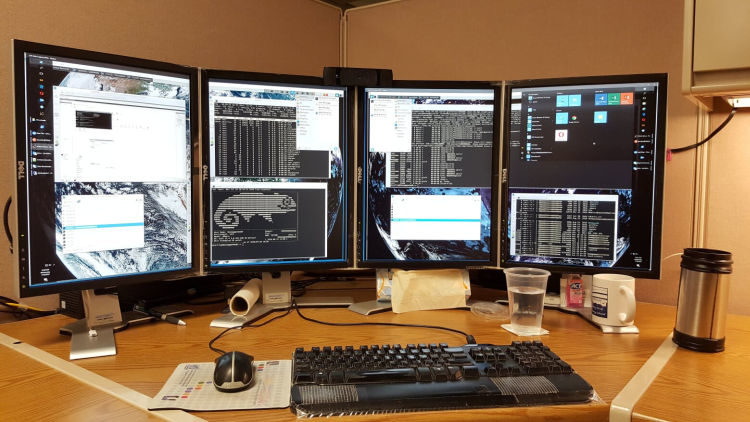TurboVNC is a high-performance, enterprise-quality version of VNC based on TightVNC, TigerVNC, and X.org.
TurboVNC contains a variant of Tight encoding that is tuned to maximize performance for image-intensive applications (such as VirtualGL, video applications, and image editors) while still providing excellent performance for other types of applications. TurboVNC, in combination with VirtualGL, provides a complete solution for remotely displaying 3D applications with interactive performance. TurboVNC’s high-speed encoding methods have been adopted by TigerVNC and libvncserver, and TurboVNC is also compatible with any other TightVNC derivative.
TurboVNC forked from TightVNC in 2004 and still covers all of the TightVNC 1.3.x features, but TurboVNC contains numerous feature enhancements and bug fixes relative to TightVNC, and it compresses 3D and video workloads much better than TightVNC while using generally only 5-20% of the CPU time of the latter. Using non-default settings, TurboVNC can also be made to compress 2D workloads as “tightly” as TightVNC.
Features include:
- Fine-grained control over the JPEG image quality and level of chrominance subsampling.
- Double buffering on the client side to reduce tearing artifacts in 3D and video applications.
- Flexible and configurable full-screen/multi-screen support.
- Full support for IPv6.
- Advanced flow control and continuous updates (greatly improves performance on high-latency connections).
- Authentication with one-time passwords or Unix login credentials (in addition to standard VNC passwords).
- Access control lists (for sharing VNC sessions with only certain users).
- Allows security/authentication policies to be set globally for a particular server machine.
- Multithreaded encoding.
- “Lossless refresh” allows a viewer to request a lossless copy of the current screen image, either manually or automatically (after a specified number of seconds of inactivity).
- High-performance zero-install Java viewer, deployable using Java Web Start, that calls libjpeg-turbo through JNI to achieve native levels of performance.
Website: turbovnc.org
Support: GitHub Code Repository
Developer: D. R. Commander
License: GNU General Public License v2.0
TurboVNC is written in C. Learn C with our recommended free books and free tutorials.
Return to Remote Desktop Clients
| Popular series | |
|---|---|
| The largest compilation of the best free and open source software in the universe. Each article is supplied with a legendary ratings chart helping you to make informed decisions. | |
| Hundreds of in-depth reviews offering our unbiased and expert opinion on software. We offer helpful and impartial information. | |
| The Big List of Active Linux Distros is a large compilation of actively developed Linux distributions. | |
| Replace proprietary software with open source alternatives: Google, Microsoft, Apple, Adobe, IBM, Autodesk, Oracle, Atlassian, Corel, Cisco, Intuit, SAS, Progress, Salesforce, and Citrix | |
| Awesome Free Linux Games Tools showcases a series of tools that making gaming on Linux a more pleasurable experience. This is a new series. | |
| Machine Learning explores practical applications of machine learning and deep learning from a Linux perspective. We've written reviews of more than 40 self-hosted apps. All are free and open source. | |
| New to Linux? Read our Linux for Starters series. We start right at the basics and teach you everything you need to know to get started with Linux. | |
| Alternatives to popular CLI tools showcases essential tools that are modern replacements for core Linux utilities. | |
| Essential Linux system tools focuses on small, indispensable utilities, useful for system administrators as well as regular users. | |
| Linux utilities to maximise your productivity. Small, indispensable tools, useful for anyone running a Linux machine. | |
| Surveys popular streaming services from a Linux perspective: Amazon Music Unlimited, Myuzi, Spotify, Deezer, Tidal. | |
| Saving Money with Linux looks at how you can reduce your energy bills running Linux. | |
| Home computers became commonplace in the 1980s. Emulate home computers including the Commodore 64, Amiga, Atari ST, ZX81, Amstrad CPC, and ZX Spectrum. | |
| Now and Then examines how promising open source software fared over the years. It can be a bumpy ride. | |
| Linux at Home looks at a range of home activities where Linux can play its part, making the most of our time at home, keeping active and engaged. | |
| Linux Candy reveals the lighter side of Linux. Have some fun and escape from the daily drudgery. | |
| Getting Started with Docker helps you master Docker, a set of platform as a service products that delivers software in packages called containers. | |
| Best Free Android Apps. We showcase free Android apps that are definitely worth downloading. There's a strict eligibility criteria for inclusion in this series. | |
| These best free books accelerate your learning of every programming language. Learn a new language today! | |
| These free tutorials offer the perfect tonic to our free programming books series. | |
| Linux Around The World showcases usergroups that are relevant to Linux enthusiasts. Great ways to meet up with fellow enthusiasts. | |
| Stars and Stripes is an occasional series looking at the impact of Linux in the USA. | |
